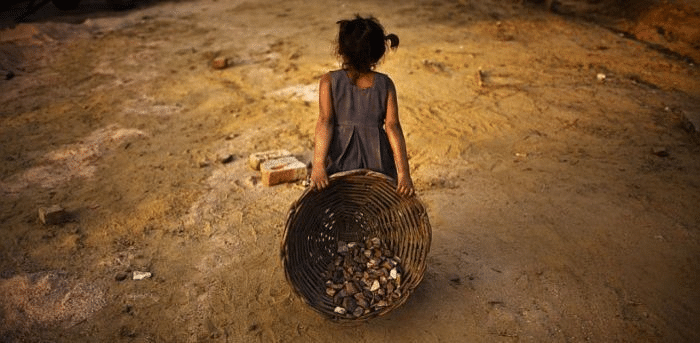
The Delhi Police and the DCPCR have seen an increase in cases of child labour during the Covid-19 pandemic which along with the lockdown has severely hit the income of families, giving an opportunity for traffickers to target the poor and persuade them to send their children to work, officials said on Sunday.
Both the Delhi Police and the Delhi Commission For Protection of Child Rights (DCPCR) have
jointly rescued several children during this time, they said.
Officials of DCPCR said with the outbreak of Covid-19 and ensuing lockdown, there has been a drastic impact on the income of families and the traffickers have been targeting poor families in various states, including Bihar, persuading them to send their children on the pretext of giving employment.
The child rights panel said it has been working to curb such cases through a multi-stakeholder approach, coordinating with all the stakeholders, including Agricultural Produce Market Committees (APMCs), Mandi Associations, Private Schools Associations among others in Delhi.
The Commission is concerned about increasing number of cases during the pandemic, said an official.
Even the International Labour Organisation (ILO) has predicted that with Covid-19 pandemic, the world may witness an increase in child labour for the first time in 20 years, thus, there is a risk of reverting years of progress in this arena, he added.
In the second week of July, the DCPCR along with the police rescued 12 child labourers from Gandhi Nagar in east Delhi. The children were found in a garment factory and cycle-motorcycle mechanic shops and they were not wearing masks and working in unsafe and unhygienic conditions, the panel had earlier said.
A few days later, the DCPCR rescued five child labourers from Okhla, who were working at a bike service centre and eateries respectively. In the same month, another rescue operation was conducted by the body along with the police, in which nine child labourers, who were working in various scrap shops in Mustafabad were rescued.
In September, 14 children allegedly trafficked from different districts of Bihar to Delhi were rescued and 10 people were arrested by the Railway unit of Delhi Police.
Among those rescued, nine children were from Katihar, two from Begusarai, two from Kishanganj and one from Purnia. The accused had planned to take them to different places, including four to Azadpur and two to Seelampur in Delhi, two to Faridabad in Haryana and six to Punjab, Harendra Kumar Singh, Deputy Commissioner of Police (Railways) had said.
Also read: Nobel laureate Kailash Satyarthi fears upsurge in child labour as Covid-19 shrivels economy
Due to the shortage of labourers amid the Covid-19 pandemic, the traffickers saw an opportunity to get the children employed in factories and targeted poor families in Bihar, the DCP had said.
In order to curb such incidents, the DCPCR has started a scheme for providing financial incentive for reporting of child labour.
Anurag Kundu, chairman of DCPCR recently urged citizens to pro-actively report instances of child labour and win cash award of up to Rs 10,000. He had also said the Commission is building an early warning system to determine child adversity using children's school attendance as an indicator.
"It is in the process of laying down processes to activate a series of actions and interventions in the event of children remaining absent from the schools for more than 50 per cent of the days. This will help mitigate the child's adversity in early stages," he had earlier said.
The Delhi Police have reorganised it's Anti-Human Trafficking Unit (AHTU). The operation 'Milap', under which children are rescued, was launched in December 2014.
Under this project, the AHTU develops information, rescues the trafficked or kidnapped person and arrests the kidnappers.
A senior Delhi police officer said many of the children who go missing belong in the age group between 12-18.
Having solved many such cases, Deputy Commissioner of Police (south) Atul Kumar Thakur said one of the noteworthy thing is that even on being scolded by parents on trivial or minor issues, children go away from their houses. Later when they reach railway stations or bus stands, they are brought to children's home and it becomes difficult for the parents to trace them.
The officer said it has been observed in some cases that parents from weaker section do not even lodge an FIR or a missing report, making it difficult to find out about the whereabouts of the children or match their photo on Zipnet (Zonal Integrated Police Network) -- which has details of the missing children or unidentified dead bodies.
"To reunite the missing children, we visit children's home where our staff speak to them and try to win their confidence so that they tell us from where they have come. In many of cases, children are initially skeptical or they do not open up easily, but after sometime, we have observed that they do share some information about their house.
"In many cases, even a small information like I have a post office near my house or a railway track goes from near my village, have helped us reunite missing children with their families," said Thakur.
Citing a similar case from his district, Deputy Commissioner of Police (Southeast) R P Meena said on September 12, during a routine visit to an observation home, a team of AHTU met a 12 year-old boy who disclosed that he hails from Loni, Ghaziabad and only remembered that a white temple was near his home, he said.
Based on that clue, Google search was used and location of all white temples were searched in Loni and finally on September 19, the family of the missing boy was traced near one white temple in Loni, he said.
When visiting children's home, the police personnel always ensure they are in civil dress and its mostly the women officers who interact with children and counsel them to make them comfortable, police officials said.